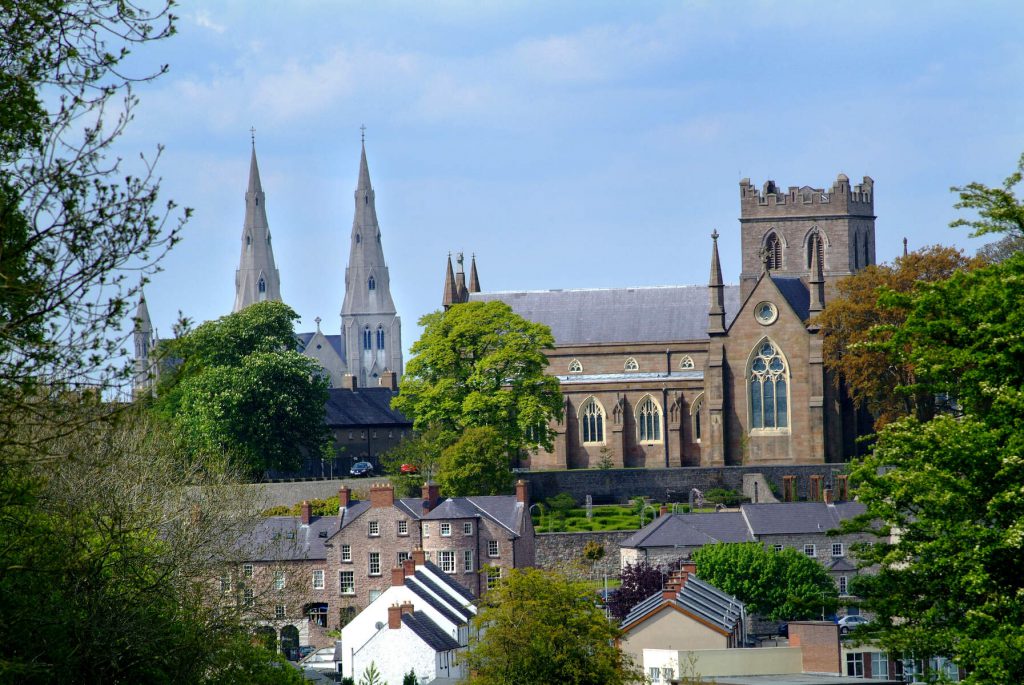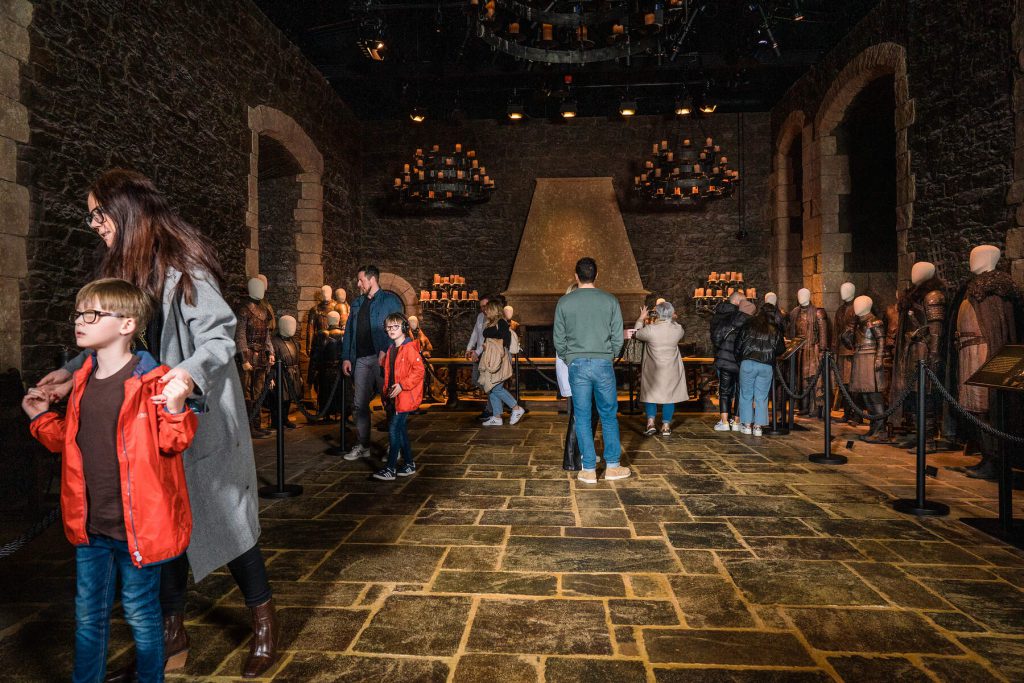
By Barry Coughlan
There’s one fair county in Ireland
With memories so glorious and grand
Where nature has lavished its bounty
It’s the orchard of Erin’s green land
I love its cathedral and city
Once founded by Patrick so true
And it bears in the heart of it’s bosom the ashes of Brian Boru
It’s my own Irish home
Far across the foam
Although I’ve often left it
In foreign lands to roam
No matter where I wander
Through cities near or far
Sure, my heart’s at home in old Ireland
In the County of Armagh
Those are some of the words of a song released by Irish folk singer Bridie Gallagher in 1957. Back then radio was king, and while I was way too young to remember the release date, it was a song that got plenty of airplay in the years that followed.
In a sense it was also before its time in that it acted as a prolonged Jingle for the tourism business. It was also an emigrant song that tore at the heart strings.
I felt it was appropriate to lead into this week’s tourism focus on Armagh by using some of the words of that now legendary song, even if Bridget “Bridie” Gallagher (1924 to 2012) was not from the county.
She was in fact known as the “Girl from Donegal” and widely regarded as Ireland’s first international pop star; she brought a piece of Ireland to many of the leading concert venues around the world, including the Royal Albert Hall, Sydney Opera House and Carnegie Hall.
The historical importance of Armagh cannot be understated.
The actual city of Armagh is the oldest in Ireland with settlement beginning there at least 6,500 years ago. Navan Fort, also known as Eamhain Mhacha, is located at the edge of Armagh City and was the capital of Ulster until the 1st century AD.
Armagh is Ireland’s ecclesiastical capital, with the spires of St. Patrick’s Church of Ireland – where Brian Boru’s tomb is believed to rest in the north wall – and St Patrick’s Catholic Cathedral dominating the skyline. Patrick built his first church on the site of the Church of Ireland Cathedral way back in 445AD and declared Armagh the home of Christianity in Ireland.
But while hundreds of thousands visit the county to pay homage to these roots, current day tourists are also taken by the impact made by the world-famous film series Game of Thrones which was filmed largely throughout Northern Ireland, including parts of Armagh.
Now a Game of Thrones Studio Tour™ has been opened in Banbridge, County Down, which, following a revamping of local government in Northern Ireland in 2015, is part of Armagh City, Banbridge and Craigavon Borough Council.
Created in official partnership with Warner Bros./WarnerMedia Consumer Products, the world’s first and only Game of Thrones Studio Tour is yet another attraction that will increasingly bring in the tourists and boost tourism yields in the years ahead.
At over 100,000 sq ft, the interactive experience reveals the world of Westeros like never before, giving fans and visitors the chance to explore the famous sets of King’s Landing, Winterfell, Dragonstone, The Wall and beyond.

It showcases the exquisite sets and creative artistry behind the incredible costumes, props, weaponry and visual effects which brought the story of Game of Thrones ® to life on screen.
The Studio Tour’s location in Banbridge, between Belfast and Dublin, means it can easily be reached by the 11 million people who visit the island of Ireland each year.
Game of Thrones has been a game-changer for Northern Ireland, and now the Studio Tour will offer fans the most immersive experience in the world.
Armagh is a small county, the smallest in Northern Ireland, and is therefore easy to explore. The quaint town of Bessbrook is a very early Quaker settlement and model village built around the linen industry in 1845.
The layout of the village remains as it was and is an attractive visitor destination, as much for the quaint nature of the village as for the fact that it can boast the Craigmore Viaduct, an 18 arch structure sweeping across the valley of the Carnlough River. It’s also home to the National Trust’s Derrymore House, an elegant 18th century thatched cottage in which the Act of Union was drawn up.
The troubles have, happily, ended and calm has returned to the staunchly Catholic population of Crossmaglen, a little hamlet burrowed in the bottom corner of South Armagh.
Today, without the controversial presence of the British Army, it is the ideal place to visit for traditional music lovers or to get a flavor of “Old Ireland” at the town’s fair day. Fishermen are well catered for in the area and watersports are a feature of activity on Lough Ross.
A ten minute drive away is the village of Cullyhanna which nestles neatly among the hills in the southwest corner of south Armagh.
It’s located on the main road between Newtownhamilton and Crossmaglen. The recently opened 18-hole Ashfield Golf Course is an attraction but Cullyhanna offers its visitors the chance to explore the religious, cultural, historical, social and archaeological interests of the area. It is home to the Cardinal O’Fiaich Heritage Center, which commemorates the life of Thomas O’Fiaich as well as bringing awareness to the heritage of the area.
Jonesboro is the closest village to the border with the Republic of Ireland and has one of Ulster’s most lively open markets, attracting large crowds to their Sunday Fair. Not far from the village lies the ruins of Moyry Castle built in the 17th century to guard the Gap of the North. The Kilsnasagart Stone is close by and is thought to be one of Ireland’s oldest Christian monuments.
Keady, lying to the south of Armagh City, is the largest of the local towns with an estimated population of over 3,000. The town was also to become a center of tailoring before the First World War, and today retains its links with clothing manufacture, with a major textiles firm affording employment for many of the local people.
The building of the canal from Newry to Lough Neagh in the 1730s brought prosperity to Portadown. Today, it’s a busy textile and manufacturing town developed with the linen industry. It has factories making carpets, industrial ceramics and jam.
There are several other cute villages and places of interest dotted throughout this easily negotiable county, but Armagh City remains the jewel in the crown. The city itself has a small population of 17,000 plus but the aforementioned Local Government District boosts the total population by a further 200,000.

The Armagh Observatory and Planetarium offers visitors a unique experience which makes it “the place for space”.
In the Planetarium’s Digital Full Dome Theatre you can sit back, relax and experience the wonders of our Universe.
The Armagh County Museum is designed like a small Greek temple; this museum features an extensive collection of specimens, documents and artefacts that reveal the rich and varied history of the County of Armagh, from prehistoric times to present-day.
Away from the obvious attractions, Armagh has open spaces that will attract walkers and hikers too. Slieve Gullion Forest Park is one such area that needs to be explored through many tranquil woodland trails, along with views over the Ring of Gullion, the Mourne Mountains and Cooley Peninsula.
These days it’s easy to sit back in the comfort of your living room and research what’s on offer for the tourist in just about every part of every country. Start looking for County Armagh on www.visitarmagh.com
*Fogra (Meaning advisory or notice): Armagh is also noted for a sport that’s largely associated with Ireland and in particular my own county of Cork. This is how it’s aptly described on Wikipedia – “(Road bowling (Irish Ból an bhóthair; also called [long]bullets) is an Irish sport in which competitors attempt to take the fewest throws to propel a metal ball along a predetermined course of country roads. The sport originated in Ireland and is mainly played in counties Cork and Armagh.
“Spectators often bet on the outcome and proffer advice to their favored competitor in the course of a match or ‘score’. Road bowling in Ireland is governed by the voluntary Irish Road Bowling Association.”
This traditional sport is also known in certain regions within the Netherlands (klootschieten), Germany (klootschiessen), and Italy. Corkman Seamus Sexton is the current individual European Champion but the big name in the sport remains another Corkman, Mick Barry, who died in 2014.
